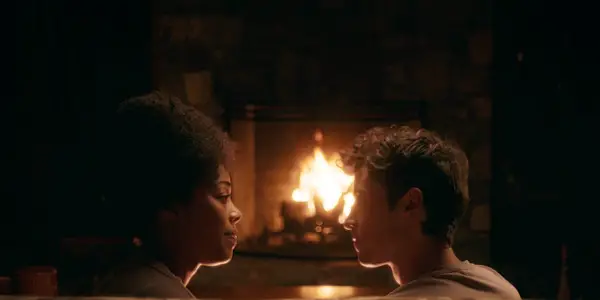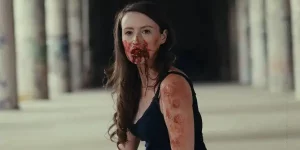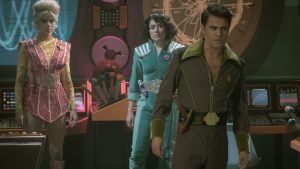
Justin Geldzahler: Oh yeah, I’ve loved making movies since I was a kid, using any school project as an excuse to make a movie with friends. I’ve always been a culture vulture, and part of the reason I love film and tv is because it combines so many art forms — storytelling and photography and actors and music and anything else you can stick in there. Count me among many people who planned their lives around decisions made in the fifth grade.After college it felt like I was facing two paths: either try to make an independent film or work my way up the writers’ room ladder in television. Making an indie felt really hard, so I went into television, parlaying my initial writers’ PA work into script coordinating and eventually researching for and consulting on shows like Succession, Euphoria, and Fosse/Verdon. The work proved to be a fantastic education, putting me right in the drafts of writers I’d admired for years, but I wasn’t finding the ladder I’d expected (and as the recent strike proves, I’m far from the only one). So after ten years, I was ready to make my first indie feature. I had no choice!
Justin Geldzahler: I’m an anxious person, so the genre’s incredibly helpful for exorcising whatever’s scaring the shit out of me, whether it’s climate change or a global pandemic or just the difficulty of maintaining any relationship with another human being. And as an artist who strives to entertain (“first, do not bore”), I value how filmmakers over the years have found ways to engage with the world making didactic message movies. Filmmakers like John Carpenter and Jordan Peele have tracked the mood of the country better than most documentarians.
Justin Geldzahler: I wrote the first draft in the Summer of 2020, so I knew I had to make something small and contained. My parents have a cabin in the Blue Ridge Mountains, which made for not only a great filming location but also a great place to write a script. Since decisions regarding cast and location were made before I started writing, Glue Trap ended up erupting a lot more from my subconscious than stories I’ve built from the ground up. Draft after draft only helped me recognize what was on the page, allowing me to draw more consciously from life, whether mimicking a particularly insufferable roommate or stealing cutting but admittedly clever lines from exes.That’s really interested. What was filming like, can you tell us a bit about the casting process and location?
source: HorrorFest FF
Justin Geldzahler: Filming was great, everyone bubbled up in the Blue Ridge Mountains as we shot the film over three weeks while omicron shut down almost every other set; we had zero positive cases thanks to our COVID coordinator Isabella VanKesteren. It was like sleepaway camp (not the 1983 movie) with everyone hanging out the whole time. I’m incredibly proud of the movie we made, but the greatest accomplishment might be that all these talented artists felt empowered to bring their craft to this script, and I’m touched by the number of friendships that were formed on that shoot.
I’d written the four main roles with actors I knew in mind, but due to production delays we had to recast the two leads (thank goodness Gloria Bangiola and Alex Warheit stayed on!). We were lucky to find Isaac W. Jay through the grapevine — as a tiny indie, we were trying to do all the casting ourselves, but there was nobody else we met who compared to him. By the time we had to recast KJ, we’d brought on Aaron Schoonover to cast her role as well as the Jenns, and he introduced us to Brittany Bradford. She challenged me in callbacks and never stopped pushing the project to be better.
It was fun filming in a location I’ve known since I was 10, so there was a real intimacy to the shoot. One snag — the night before production started, the water stopped running in the cabin… which was especially bad for me since Gloria and I were planning to stay there through production. The cast and crew were total troopers, making use of the woods and shuttle to basecamp as best they could, and thankfully we had running water after the first week (and drinkable water after the second).
Do you have any horror films that inspired you (or films in general)?
Justin Geldzahler: I knew I wanted Glue Trap to be uncomfortable — and not just because that’s cheaper than gore — so we drew as much from horror films as much as cringe comedies. I found inspiration in slow burn American horror like Always Shine and The House of the Devil, awkward northern European comedies like Force Majeure and Toni Erdmann, and Black independent filmmakers like Charles Burnett (particularly To Sleep With Anger) and Kathleen Collins (Losing Ground).
What are you hoping audiences will take away from the film?
Justin Geldzahler: Recommendations for all their friends to see it. And maybe some appreciation for the more difficult people they love.
How has the festival been so far for you? Is this your first time at a fest?
Justin Geldzahler: I’ve attended a few as an audience member, but this is my first time going to festivals with my own movie. And it’s been wonderful traveling all over the country with Glue Trap and seeing how different audiences react. Sometimes the comedy plays stronger, other times it’s the tension, and I haven’t seen any walkouts yet. The run’s been great, taking me all over the country, from cities I’ve called home to places I’d longed to visit — right now I find myself in the awe inspiring deserts of southern Utah thanks to HorrorFest International.
How important do you think festivals are to smaller, indie projects?
Justin Geldzahler: They’re incredibly important, providing not only a platform for indie films to build audiences and get press but also a great way to meet other filmmakers and maybe even future collaborators.
Lastly, what’s next?
Justin Geldzahler: It depends what I can find the money for, since I’d love to make the next movie not at my parents’ house. I have a low-budget creature feature that’s kinda early Cronenberg mixed with family relationships and could be shot in any city with generous tax credits and an available apartment building. There’s also a home invasion script that’s really just an outlet for my climate anxiety called The House Is On Fire. But it’s set in the Connecticut mansion of an oil CEO, and as the title implies a bit of damage goes down; I learned firsthand on Succession that money’s needed to depict these rarified worlds. Of course, little is happening until the AMPTP offers a fair deal to SAG-AFTRA.
I can’t wait to see! Truly loved the film!
Does content like this matter to you?
Become a Member and support film journalism. Unlock access to all of Film Inquiry`s great articles. Join a community of like-minded readers who are passionate about cinema – get access to our private members Network, give back to independent filmmakers, and more.







